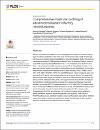Comprehensive molecular profiling of advanced/metastatic olfactory neuroblastomas.
| المؤلف | Topcagic, Jasmina |
| المؤلف | Feldman, Rebecca |
| المؤلف | Ghazalpour, Anatole |
| المؤلف | Swensen, Jeffrey |
| المؤلف | Gatalica, Zoran |
| المؤلف | Vranic, Semir |
| تاريخ الإتاحة | 2019-04-04T08:31:53Z |
| تاريخ النشر | 2018-01-11 |
| اسم المنشور | PLoS ONE |
| المعرّف | http://dx.doi.org/10.1371/journal.pone.0191244 |
| الاقتباس | Topcagic J, Feldman R, Ghazalpour A, Swensen J, Gatalica Z, Vranic S (2018) Comprehensive molecular profiling of advanced/ metastatic olfactory neuroblastomas. PLoS ONE 13 (1): e0191244. https://doi.org/10.1371/journal. pone.0191244 |
| الملخص | Olfactory neuroblastoma (ONB) is a rare, locally aggressive, malignant neoplasm originating in the olfactory epithelium in the nasal vault. The recurrence rate of ONB remains high and there are no specific treatment guidelines for recurrent/metastatic ONBs. This study retrospectively evaluated 23 ONB samples profiled at Caris Life Sciences (Phoenix, Arizona) using DNA sequencing (Sanger/NGS [Illumina], n = 15) and gene fusions (Archer FusionPlex, n = 6), whole genome RNA microarray (HumanHT-12 v4 beadChip, Illumina, n = 4), gene copy number assays (chromogenic and fluorescent in situ hybridization), and immunohistochemistry. Mutations were detected in 63% ONBs including TP53, CTNNB1, EGFR, APC, cKIT, cMET, PDGFRA, CDH1, FH, and SMAD4 genes. Twenty-one genes were over-expressed and 19 genes under-expressed by microarray assay. Some of the upregulated genes included CD24, SCG2, and IGFBP-2. None of the cases harbored copy number variations of EGFR, HER2 and cMET genes, and no gene fusions were identified. Multiple protein biomarkers of potential response or resistance to classic chemotherapy drugs were identified, such as low ERCC1 [cisplatin sensitivity in 10/12], high TOPO1 [irinotecan sensitivity in 12/19], high TUBB3 [vincristine resistance in 13/14], and high MRP1 [multidrug resistance in 6/6 cases]. None of the cases (0/10) were positive for PD-L1 in tumor cells. Overexpression of pNTRK was observed in 67% (4/6) of the cases without underlying genetic alterations. Molecular alterations detected in our study (e.g., Wnt and cKIT/PDGFRA pathways) are potentially treatable using novel therapeutic approaches. Identified protein biomarkers of response or resistance to classic chemotherapy could be useful in optimizing existing chemotherapy treatment(s) in ONBs. |
| راعي المشروع | Olfactory neuroblastoma (ONB) is a rare, locally aggressive, malignant neoplasm originating in the olfactory epithelium in the nasal vault. The recurrence rate of ONB remains high and there are no specific treatment guidelines for recurrent/metastatic ONBs. This study retrospectively evaluated 23 ONB samples profiled at Caris Life Sciences (Phoenix, Arizona) using DNA sequencing (Sanger/NGS [Illumina], n = 15) and gene fusions (Archer Fusion- Plex, n = 6), whole genome RNA microarray (HumanHT-12 v4 beadChip, Illumina, n = 4), gene copy number assays (chromogenic and fluorescent in situ hybridization), and immunohistochemistry. Mutations were detected in 63% ONBs including TP53, CTNNB1, EGFR, APC, cKIT, cMET, PDGFRA, CDH1, FH, and SMAD4 genes. Twenty-one genes were overexpressed and 19 genes under-expressed by microarray assay. Some of the upregulated genes included CD24, SCG2, and IGFBP-2. None of the cases harbored copy number variations of EGFR, HER2 and cMET genes, and no gene fusions were identified. Multiple protein biomarkers of potential response or resistance to classic chemotherapy drugs were identified, such as low ERCC1 [cisplatin sensitivity in 10/12], high TOPO1 [irinotecan sensitivity in 12/19], high TUBB3 [vincristine resistance in 13/14], and high MRP1 [multidrug resistance in 6/6 cases]. None of the cases (0/10) were positive for PD-L1 in tumor cells. Overexpression of pNTRK was observed in 67% (4/6) of the cases without underlying genetic alterations. Molecular alterations detected in our study (e.g., Wnt and cKIT/ PDGFRA pathways) are potentially treatable using novel therapeutic approaches. Identified protein biomarkers of response or resistance to classic chemotherapy could be useful in optimizing existing chemotherapy treatment(s) in ONBs. |
| اللغة | en |
| الناشر | Public Library of Science |
| الموضوع | olfactory neuroblastoma esthesioneuroblastoma molecular profiling targeted therapy |
| النوع | Article |
الملفات في هذه التسجيلة
هذه التسجيلة تظهر في المجموعات التالية
-
أبحاث الطب [1904 items ]


